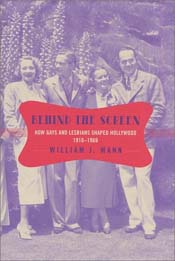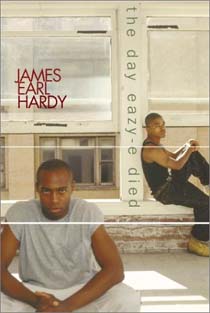 |
|
Any attempt to select the best books of the year is limited by this critic's inability to read all of the many books that were published in 2001. Even after limiting my scope to LGBT books published in the English language (which left out Mariana Romo-Carmona's excellent Conversaciones), I found it difficult to whittle my list down to the mandatory ten. But here it is, and in alphabetical order:
 1. Behind the Screen:How Gays and Lesbians Shaped Hollywood, 1910-1969, by William J. Mann, Viking. Mann, William Haines's biographer, has joined the ranks of Vito Russo and David Ehrenstein with this social history of gay Hollywood. Tinseltown has had a flourishing gay colony since the beginning, Mann writes, and many of its members made great contributions to the cinema. Unlike other books about "gays in the movies", Behind the Screen deals with writers, directors, costume and set designers as well as movie stars. Behind the Screen is also InsightOutBooks' "Book of the Year".
1. Behind the Screen:How Gays and Lesbians Shaped Hollywood, 1910-1969, by William J. Mann, Viking. Mann, William Haines's biographer, has joined the ranks of Vito Russo and David Ehrenstein with this social history of gay Hollywood. Tinseltown has had a flourishing gay colony since the beginning, Mann writes, and many of its members made great contributions to the cinema. Unlike other books about "gays in the movies", Behind the Screen deals with writers, directors, costume and set designers as well as movie stars. Behind the Screen is also InsightOutBooks' "Book of the Year".
 3. The Day Ezay-E Died, by James Earl Hardy, Alyson Books. This is the fourth volume in Hardy's series of gay, hip-hop love stories. Here Hardy uses the continuing relationship between Mitchell Crawford and Raheim Rivers and the 1995 death of rapper Eazy-E as vehicles to discuss AIDS in the hip-hop community. Covering three eventful weeks in Raheim's life, The Day Eazy-E Died covers topics ranging from racism in the gay community and homophobia in the African-American community to AIDS denial, fear of AIDS, being a father and being a lover, all in just 178 pages. If nothing else, The Day Eazy-E Died should remind people of an epidemic which is still the # 1 killer of black men.
3. The Day Ezay-E Died, by James Earl Hardy, Alyson Books. This is the fourth volume in Hardy's series of gay, hip-hop love stories. Here Hardy uses the continuing relationship between Mitchell Crawford and Raheim Rivers and the 1995 death of rapper Eazy-E as vehicles to discuss AIDS in the hip-hop community. Covering three eventful weeks in Raheim's life, The Day Eazy-E Died covers topics ranging from racism in the gay community and homophobia in the African-American community to AIDS denial, fear of AIDS, being a father and being a lover, all in just 178 pages. If nothing else, The Day Eazy-E Died should remind people of an epidemic which is still the # 1 killer of black men.
6. Rainbow Boys, by Alex Sanchez, Simon & Schuster. This challenging (and controversial) young adult novel is about a high school triangle in which all three parties are boys. Openly gay Nelson, discreet Kyle and closeted Jason are three teenagers whose lives collide at Rainbow Youth, a gay-straight alliance that Nelson is trying to start in their school. Though Rainbow Boys deals with such "heavy" topics as gay-bashing and AIDS, Sanchez manages to keep the narrative light, which makes this the idea book for queer boys and those who love them.
 7. Rebel Yell: Stories by Contemporary Southern Gay Authors, edited by Jay Quinn, Harrington Park Press. The last 18 months have been busy ones for Jay Quinn. In addition to being an editor for Harrington's Southern Tier line of gay books, Quinn has written a memoir (The Mentor) and a novel (Metes and Bounds) and edited this fascinating and unique collection of gay Southern fiction. In Rebel Yell, writers like Robin Lippincott, Jameson Currier, Walter Holland and Quinn himself examine the problems and pleasures of being gay in Dixie as only gay Southerners can.
7. Rebel Yell: Stories by Contemporary Southern Gay Authors, edited by Jay Quinn, Harrington Park Press. The last 18 months have been busy ones for Jay Quinn. In addition to being an editor for Harrington's Southern Tier line of gay books, Quinn has written a memoir (The Mentor) and a novel (Metes and Bounds) and edited this fascinating and unique collection of gay Southern fiction. In Rebel Yell, writers like Robin Lippincott, Jameson Currier, Walter Holland and Quinn himself examine the problems and pleasures of being gay in Dixie as only gay Southerners can.
9.The Sappho Companion, edited by Margaret Reynolds, St. Martin's Press. Enough has been written about Psappha (as the Greeks call her), to fill a bookcase. The Sappho Companion is a collection of writings by and about "the ninth muse." Though only fragments of Sappho's poetry survives, it was enough for generations of scholars (mostly men) to re-create her in their own image. Throughout the years, Sappho was deemed by various scholars, students and fans to be a courtesan, a "wanton", a "learned lady" and a lesbian-feminist. Perhaps we are all mistaken.
 10. Sleep Demons: An Insomniac's Memoir, by Bill Hayes, Washington Square Press. Bill Hayes is one of 40 million Americans who suffer from sleep disorders. Unlike the rest of us, Hayes wrote a book about it. Sleep Demons: An Insomniac's Memoir combines personal narrative with a detailed discussion of the various sleep disorders that have plagued humanity since the days of Morpheus. Queer readers will rejoice that Hayes makes no bones about being gay, and incorporates his personal struggles and those of his lover (a PWA) into the narrative.
10. Sleep Demons: An Insomniac's Memoir, by Bill Hayes, Washington Square Press. Bill Hayes is one of 40 million Americans who suffer from sleep disorders. Unlike the rest of us, Hayes wrote a book about it. Sleep Demons: An Insomniac's Memoir combines personal narrative with a detailed discussion of the various sleep disorders that have plagued humanity since the days of Morpheus. Queer readers will rejoice that Hayes makes no bones about being gay, and incorporates his personal struggles and those of his lover (a PWA) into the narrative.
|


 2. Courting Justice: Gay Men and Lesbians v. The Supreme Court, by Joyce Murdoch & Deb Price, Basic Books. Journalists/life partners Price and Murdoch have written a massive study of the Supremes' less than ideal record on LGBT issues. As Murdoch and Price tell us, for every pro-gay decision the Court handed down there has been at least two rulings that upheld antigay legislation or allowed others (like the Boy Scouts) to discriminate with impunity. In this the worst culprits are not the outright bigots like Rehnquist or Scalia but the well-meaning but ignorant magistrates (like Lewis Powell) whose decisions often tipped the scales of justice against us.
2. Courting Justice: Gay Men and Lesbians v. The Supreme Court, by Joyce Murdoch & Deb Price, Basic Books. Journalists/life partners Price and Murdoch have written a massive study of the Supremes' less than ideal record on LGBT issues. As Murdoch and Price tell us, for every pro-gay decision the Court handed down there has been at least two rulings that upheld antigay legislation or allowed others (like the Boy Scouts) to discriminate with impunity. In this the worst culprits are not the outright bigots like Rehnquist or Scalia but the well-meaning but ignorant magistrates (like Lewis Powell) whose decisions often tipped the scales of justice against us.
 5. Queer Pulp: Perverted Passions from the Golden Age of the Paperback, by Susan Stryker, Chronicle Books. Queer Pulp is the well-illustrated history of queer paperbacks, commonly called "pulps". It looks back at the "golden age" of paperbacks (1945-65), when books about lesbian, bisexual or transgendered people were published to appeal to a new generation of pseudo-sophisticates. (Gay male pulps flourished after 1965, and were mostly tied to the rise in pornographic literature.) Queer Pulp includes, for our viewing pleasure, cover shots of such classics as Lavender Love Rumble, Hangout for Queers, AC-DC Lover, A Madam's Memoir and I Changed My Sex.
5. Queer Pulp: Perverted Passions from the Golden Age of the Paperback, by Susan Stryker, Chronicle Books. Queer Pulp is the well-illustrated history of queer paperbacks, commonly called "pulps". It looks back at the "golden age" of paperbacks (1945-65), when books about lesbian, bisexual or transgendered people were published to appeal to a new generation of pseudo-sophisticates. (Gay male pulps flourished after 1965, and were mostly tied to the rise in pornographic literature.) Queer Pulp includes, for our viewing pleasure, cover shots of such classics as Lavender Love Rumble, Hangout for Queers, AC-DC Lover, A Madam's Memoir and I Changed My Sex.
 8. Rebels, Rubyfruit and Rhinestones: Queering Space in the Stonewall South, by James T. Sears, Rutgers University Press. The second volume in Sears's history of the LGBT South covers the decade between the Stonewall Uprising and the first March on Washington (1969-79). Combining biography and history, RR&R celebrates an era when "the homophile generation marked by gradualism, civility, and accommodation gave way to the rubyfruit generation characterized by immediacy, confrontation, and resoluteness." (For the record, I was one of the "characters" featured in Dr. Sears's book.)
8. Rebels, Rubyfruit and Rhinestones: Queering Space in the Stonewall South, by James T. Sears, Rutgers University Press. The second volume in Sears's history of the LGBT South covers the decade between the Stonewall Uprising and the first March on Washington (1969-79). Combining biography and history, RR&R celebrates an era when "the homophile generation marked by gradualism, civility, and accommodation gave way to the rubyfruit generation characterized by immediacy, confrontation, and resoluteness." (For the record, I was one of the "characters" featured in Dr. Sears's book.)